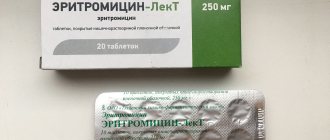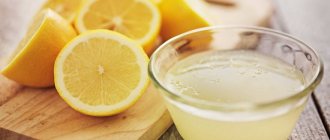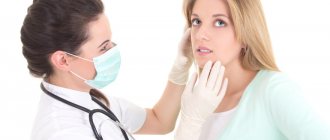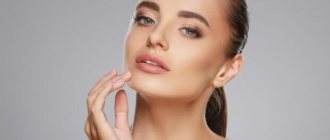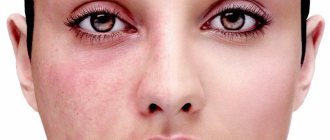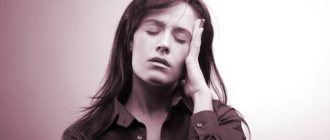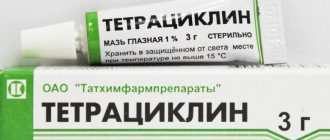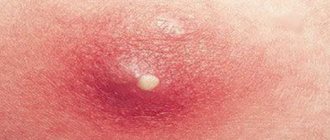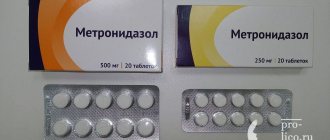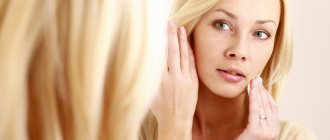Exogenous factors
The evolution of the morphological elements of acne is as follows: closed comedones and milia, open comedones, follicular papules and nodes, follicular pustules, scars and spots (vascular, hyper- and hypopigmented).
Comedones
Closed comedones are small superficial internal skin cysts - whitish or slightly yellowish vesicles filled with sebum and epidermal cells), no more than 1 mm in size, rising above the skin or located in the thickness of the skin, determined by palpation in the form of small compactions.
Open comedones look like dots with a diameter of 0.1 to 1 mm, sometimes they rise above the skin. Their color can be light yellow, brown and even black.
Papules
A follicular papule is a small cone-shaped pink or bright red nodule with a diameter of 1-3 mm. Usually rises above the skin, has an inflammatory infiltrate around it.
Pustules
Pustules - papules turn into them over time, there are transitional stages - “papulo-pustules”. Pustules can be superficial, when blisters - yellowish pustules are located close to the surface of the skin, or deep.
Over time, the pustules burst, releasing pus, and heal with the formation of temporary thickenings of the epidermis. Scars do not form in their place, but bluish spots may remain, more often due to injury or squeezing out acne.
Small pustules dry out without separation of pus when drying agents are used.
Nodes are deep inflammatory elements, reach the size of a pea or larger, are painful, dense, adherent to the surface of the skin, take a long time to resolve, can exist for weeks, and after involution they heal with the formation of scars.
Creams
To treat acne, the following cream is used in combination with other products:
- Zenerite. When applied, an invisible film is formed on the face, which prevents the entry and proliferation of harmful microbes. It contains an antibiotic and will get rid of rashes in a short time. And regular use cleanses the bark and relieves acne for a long time.
- Aven. Soothes the skin, helps with acne and acne. Regulates sebum secretion. Country of origin: France, expensive drug. Suitable for dry and aging skin. The cream is applied in the evening, avoiding the lips and eyes.
- Floresan. Dries out acne, eliminates inflammation and redness. The composition of the cream instantly destroys bacteria. Apply morning and evening for 30 minutes, then remove with a cotton pad. Another advantage is the low price and pleasant smell. The disadvantages include that on hot days it can be seen on the face.
Antiseptic ointments
Remedies for acne on the face for teenagers, such as ointments, occupy a leading position:
- Ichthyol ointment is an inexpensive and accessible remedy that treats acne and removes unpleasant consequences (scars). The ointment not only draws out the contents, but also tightens traces of it. To achieve the effect, apply a thin layer, 2 times a day. An hour after applying ichthyol ointment, treat the skin with lotion. To prevent itching and burning.
- Sulfuric ointment effective for pimples and acne, has antimicrobial and antiparasitic effects. It has a characteristic smell of sulfur. It is better to use it at night, leave it for about 4 hours, then wash it off.
- Yam ointment is a combined preparation containing: salicylic acid, sulfur, zinc oxide. Softens the skin and relieves inflammation. Before application, mix the ointment and cover the skin with a thin layer for 5 minutes. Then remove with a cotton pad soaked in baby oil or cream. The next 2 days, add 5 minutes at a time until you reach 15 minutes.
Don't miss the most popular article in the section: Facial massage according to the system of the Japanese doctor Asahi Zogan.
Causes
Teenage acne on the skin, in addition to hormonal changes, can be triggered by the following factors:
- Unstable emotional and psychological background characteristic of a developing organism.
- The pathological inflammatory process begins with the formation of a sebaceous plug in the gland duct. So much sebaceous secretion is produced that it constantly accumulates in the excretory cavity, thickens and forms subcutaneous infiltrates.
The following factors usually influence the appearance of acne in teenagers:
- genetic;
- seasonal and climatic;
- hormonal changes during puberty;
- diseases of the liver and gastrointestinal tract;
- poor nutrition;
- stress;
- disruption of the functioning of the endocrine glands;
- improper skin care or lack thereof: for example, abuse of powder, foundation;
- prolonged exposure to the sun.
Excessive sebum production leads to clogged pores. Also, the pores can become clogged with horny scales of the follicular duct, then a microcomedone is formed - closed or open (“black dots”).
Blockage of the sebaceous gland duct prevents air access, which causes bacteria to multiply.
Acne often develops during periods of hormonal surges in the body. There are also other common reasons, such as:
Hormonal disbalance . At the time of puberty, the level of sex hormones in the body rises. This leads to a malfunction in the nervous system and increases the activity of the sebaceous glands, as a result of which, due to an excess of fatty secretion, the pores become clogged and rashes appear.
Avitaminosis. Deficiency of vitamin A and B vitamins also suggests skin problems. Their lack indicates an incorrect diet. It is these vitamins that affect the stability of the glands and the renewal of processes in skin cells.
Oily skin . The oiliness of the epidermis can be influenced by genetic factors and hormonal imbalances, which increase the production of sebaceous secretions.
Demodicosis . Demodex is an intradermal mite that lives on almost any person. However, a favorable environment for its activation is excessively oily skin and increased levels of hormones.
Acne severity in teenagers
- Mild - comedonal acne - up to 20 comedones, up to 10 pustules. There are no nodes, cysts, fistulas, inflammations, scars.
- Moderate - papulopustular acne - more than 20 comedones, 10-20 pustules, up to 10 nodes, there are clear signs of inflammation. There are no cysts, fistulas, scars.
- Severe - papulopustular acne - more than 20 comedones, more than 20 pustules, 10-20 nodules, many cysts and fistulas, severe inflammation, scars are present.
- Very severe - conglobate acne - multiple comedones and pustules, more than 20 nodes, many cysts and fistulas, very severe inflammation, many scars.
How to get rid of acne for a teenager: folk remedies
The main thing in treating acne is to balance the pH level of the skin and prevent the growth of bacteria. A good home remedy is washing with acidic liquids. You can mix 1 part apple cider vinegar with 10 parts boiled water and apply it to the skin with a cotton swab.
Freshly squeezed lemon juice helps cleanse the skin. It is applied directly to clean skin for a few minutes. Wash off the juice with cool water.
Honey contains enzymes that act as an antimicrobial agent. A thin layer of raw honey is applied to the face and left for 5 – 7 minutes. This removes bacteria and dirt from the pores.
Many organic oils are natural antibiotics and antiseptics. If you lightly lubricate the heads of pimples with tea tree or jojoba oil three times a day, inflammation quickly passes and does not recur.
Herbalists know many ways to treat oily skin with inflamed comedones.
For example:
• 10 min. Boil 2 tbsp in a glass of water. spoons of dry St. John's wort leaves. Strain. Wash your face and neck with the cooled mixture;
• pour a glass of boiling water into a ceramic container with 1 tbsp. spoon of dry calendula petals. In 20 minutes. strain. Use chilled for washes and lotions;
• apply for 20 minutes. mashed wild strawberries or viburnum.
All sour berries and fruits cleanse oily skin, disinfect and heal acne: apple, cranberry, lemon. The mashed pulp is mixed with raw egg white and applied to the face. Procedure time – 20 minutes. The composition is washed off with warm water.
Herbal infusions for rubbing and lotions
Another effective way to combat teenage acne is the use of herbal tinctures and lotions.
- Aloe leaf is used to eliminate acne. Place the cut leaf in the refrigerator for a couple of minutes, then chop it and add a small amount of boiled water. Leave for an hour, then boil for about 3 minutes. Wipe your face with the prepared tincture.
- Calendula with honey. Pour one glass of boiled water into 1 tsp. dry calendula with added honey, mix thoroughly. Make lotions and apply to areas with acne for half an hour.
- Birch sap works well against acne. Washing your face in the morning and evening will keep your skin healthy for a long time.
- Cucumber-based lotions will work well for acne. Grate the vegetable and pour boiling water over it, let it brew for 4 hours. Use as compresses.
Acne symptoms
Juvenile acne can be open or closed.
Closed comedones are white nodules that are not visible on the skin surface. Due to the fact that dust accumulates in the pores over time, black spots appear on the epithelium of the skin and come to the surface. They are usually found in the forehead and chin area.
If an existing acne continues to inflame, and treatment does not arrive and it cannot be gotten rid of in time, a pimple will appear, which is characterized as a red-blue dense lump under the skin that looks like a pea.
Large bubbles like these can leave scars. They need to be treated.
Steam baths
Deep cleansing methods prevent the appearance of acne.
Steam baths based on medicinal herbs are suitable for these purposes:
- Chamomile. This medicinal plant has antiviral and antimicrobial effects. For 1 tbsp. l. chamomile take 500 l. water, boil for 20 minutes. Keep your face above the steam, while covering your head with a terry towel. Carry out the procedure for a quarter of an hour. It is not recommended to go outside immediately.
- Rose petals have a cleansing and refreshing effect. A sieve is placed in a deep container of water, where rose petals are placed. The session is spent for a quarter of an hour, holding your face above the steam.
- Mint. Take 1 tbsp per glass of water. a spoonful of mint. Bring to a boil, leave for 15 minutes. Keep your face over the steam for 5 to 10 minutes.
Such procedures are recommended to be carried out before using masks and ointments for acne; they cleanse well and open the pores.
Proper care for problem skin
A guarantee of healthy skin without acne is proper care:
- Cleansing. This procedure should be done in the morning and evening. Scrubs and tonics will cope with the task. But it is best to use tar soap; it dries and disinfects the skin. Then wipe your face with lotion.
- Moisturizing. Moisturizing masks and creams are suitable for this purpose. You can apply lanolin cream to your face; it perfectly nourishes problematic skin.
- Nutrition. This is done using nourishing masks, which you can purchase in stores or prepare yourself. Grate the zucchini and cucumber, mix with a spoon of honey, leave for 15 minutes and rinse with water. This mask perfectly nourishes and heals the skin.
The appearance of acne on the face of teenagers has different causes, but you can get rid of them with the help of ready-made pharmaceutical products and traditional medicine recipes. And also without forgetting about prevention, nutrition and hygiene.
Acne treatment
Common pubertal acne does not require serious treatment. However, not only a dermatologist treats it; he can advise the teenager to seek help from a nutritionist.
A nutritionist will analyze the teenager’s diet, and then remove from it all products that provoke comedogenicity, for example, sweets, carbonated drinks, chocolate, strong hot drinks such as coffee and tea, river fish, seaweed and foods with a high iodine content.
When treating mild to moderate acne, it is best to combine topical products and careful daily facial skin care. There are two modern, effective and safe drugs for external use: Baziron and Skinoren.
“Baziron” is necessary to suppress bacterial colonies, exfoliate dead skin cells, and oxidize sebaceous secretions.
It also prevents the formation of blackheads. Apply to a cleansed face pointwise, twice a day, the result appears after several months of regular use.
Side effects include overdrying of the skin, leading to flaking.
"Skinoren" is based on azelaic acid, which has a complex mechanism of action.
The product inhibits bacterial growth, disinfects the skin, and treats inflammation. In addition, Skinoren helps lighten post-acne scars.
In the first few days, it may cause discomfort in the application area, manifested in tingling, irritation and local redness.
Improvements will become noticeable after 6 months of regular use. Used spot-on, once a day. There are practically no side effects unless the dosage is exceeded.
To begin with, the skin should be cleaned and dried, then apply the ointment to the acne lesions, avoiding its contact with healthy skin.
Regular use is also important, since it is impossible to get rid of acne in one day. After the onset of stable remission, Skinoren and Baziron can sometimes be used for preventive purposes.
The technique appeared relatively recently, but has managed to prove itself positively. Clogged sebaceous ducts open painlessly, excess sebum is removed, and a layer of keratinized and dead cells is removed.
Remember!
First of all, it is necessary to determine the nature and scale of the rash.
Secondly, visit a doctor. Use all medications only after consultation with him.
Well, thirdly, remember: acne goes away on its own by the age of 24-25, when hormonal changes end.
Be healthy!
Please rate this article.
Click on the heart to vote.
Overall rating 4.7 / 5. Voted: 3
No votes yet. You will be the first!
I'm sorry you didn't like the article. We will try to improve it according to your feedback.
How to make the text better?
Please tell me how we can improve the article?
How to treat acne in teenagers
Often, various therapeutic methods, as well as cosmetics, lead to remission, or, less often, to a solution to the problem. When choosing therapy, you should rely not only on the severity of acne, but also take into account the general condition of the teenager.
Main objectives of treatment:
- prevent the formation of comedones;
- remove comedones;
- reduce sebum production;
- prevent the opening of comedones and the development of inflammation;
- use combination therapy;
- prevent the appearance of scars.
Remedies used externally in the treatment of acne in adolescents are used when there are no signs of inflammation.
Their action is aimed at reducing the formation of new acne. Typically, dermatologists prescribe drugs to treat acne such as:
Special gels, lotions, and creams are good for treating acne on the back and other parts of the body. They contain agents that can soften hard plugs and open pores.
These can be antibiotics, comedolytics, sulfur, resorcinol. Adolescents can use such drugs from several months to 1 year.
Acne medications containing erythromycin, clindamycin, tetracycline, doxycycline and sulfamethoxazole are taken for 2 to 4 months.
Taking them may be accompanied by indigestion, dizziness, allergic reactions, genital candidal infections and even discoloration of teeth.
Treatment of acne in adolescents with its moderate form consists of minimizing inflammatory changes and preventing the formation of new acne.
They need to be used for 2 – 4 months.
Severe forms of acne require the use of isotretinoin orally, which reduces the secretion of sebum. In combination with antibiotics, this drug is taken for 4–5 months.
Juvenile acne usually does not require global treatment. It may be limited to the use of special cleansers that can degrease the skin and normalize sebum secretion.
After analyzing the diet of a growing child, it is necessary to eliminate chocolate, strong tea, coffee, fish, seaweed and all iodine-containing products from it.
What food should be constantly present in the diet of a young person suffering from acne? It is like this:
- foods high in zinc (crabs, shrimp, soybeans);
- foods rich in fiber;
- any fermented milk products;
- fruits and vegetables.
When teenagers or their parents turn to doctors for help, the rash usually has a moderate or severe form, which cannot be cured without a thoughtful, comprehensive approach.
To begin with (especially girls), you need to contact a cosmetologist who will draw up the simplest plan for a teenager, aimed at preventing new rashes and eliminating old ones.
Approximately the therapy will look like this:
- Special diets reduce sebum production.
- Acne inflammation is treated using cosmetic procedures that can suppress pathogenic organisms inside the follicle - microcurrent therapy, neodymium laser treatment.
- Comedones and pustules are removed using mechanical, vacuum, ultrasound or chemical methods.
- They cleanse pores and remove dead cells with one of the types of peeling. This reduces possible scarring.
- Stimulate regenerative processes using mesotherapy and cryotherapy.
A regular remedy is prescribed for home antiseptic treatment and removal of excess fat.
Dalatsin T, Zenerit, Clindamycin, Skinoren have complex effects of this kind.
The most affordable option is to use salicylic acid, which includes both cheap salicylic alcohol and the widely advertised CLEAN & CLEAR ADVANTAGE.
If the rash is complicated by atheromas or boils, you cannot do without a dermatologist. The doctor will conduct an examination and send the teenager for additional consultations with an endocrinologist, gastroenterologist, or gynecologist so that they can help detect and eliminate the root cause of the disease.
For his part, the dermatologist is obliged to prescribe and monitor the use of drugs that are potentially dangerous and not used in cosmetology:
Pharmacy tinctures
Pharmacy tinctures will help with acne:
- Calendula tincture has an antimicrobial effect. It not only gets rid of acne, but also prevents scarring. Destroys pathogenic flora, soothes the skin. The tincture contains vitamin A, which reduces skin oiliness and promotes tissue regeneration.
- Tincture of celandine. To prepare the decoction 1 tbsp. l. pour 1.5 cups of water, boil (5 minutes) and let sit for about 5 hours. Then strain and use as a lotion before bed. The tincture dries out the skin; use only on problem areas. It will get rid of the rash in a short time.
- Propolis tincture. An inexpensive antimicrobial agent, an analogue of an antibiotic. When diluted with water, it can be used as a tonic for daily washing. Recommended for oily and combination skin.
Retinoid ointments
The principle of action of such drugs is similar to the effect of vitamin A:
- Adapalene belongs to a new generation of retinoids, a synthetic analogue of vitamin A. In cosmetology it is used to treat pimples and acne. The drug saturates the skin with molecules, which in turn break down fat. Contains particles that work as an antibiotic and relieve inflammation. Before use, wash off makeup, apply a small amount, using a spot method. Rub the gel or cream with light movements until completely absorbed into the skin. Dermatologists recommend using this drug once a day. With a frequency of 2 or 3 times a week. Suitable for people with dry skin type.
- Isotretinoin is an antiseborrheic and anti-inflammatory agent. Suppresses the activity of the sebaceous glands, which has a beneficial effect on the condition of the skin. The drug not only eliminates acne, but also reduces the depth of wrinkles. Available in both ointment and tablet form. The course lasts 24 weeks.
Antibiotic for oral administration
Products to reduce sebum production. Preparations based on retinoic acid are widely known - Adapalene, Tretinoin, Roaccutane, retinoic ointment.
Boys' androgen levels constantly increase as they grow up, so they need acne treatment much more often than girls of the same age.
Modern medicine has many methods for treating teenage rash. The intensity of the course of therapy depends on the number of rashes and the stage of development of the skin disease.
Sometimes the issue of teenage acne resolves itself as the boy grows older, but hoping for this can cause harm to the child’s health and miss the onset of a serious skin disease.
Proper nutrition
To get rid of acne for a long time, a proper balanced diet will help, which you should pay special attention to:
- you need to eat 5-6 times a day in small portions;
- include vegetables and fruits in the menu;
- reduce the consumption of fried and salty foods;
- exclude coffee and sweet water;
- include sea fish and seafood in the menu.
A balanced diet is the key to healthy skin and the whole body during adolescence.
Hormonal drugs
Acne on the face in teenagers can occur as a result of hormonal imbalance. The remedies in this case should be hormonal.
The most effective are:
- Yarina - the drug is divided into two groups: monophasic and triphasic. The use of contraception helps to get rid of pimples, acne and acne. The package contains 21 tablets. The first tablet is taken on the first day of menstruation, following the instructions on the package, after which a seven-day break is taken.
- Jess. The action is the same as that of the drug Yarina, they differ in dosage. Jess contains less ethinyl estadiol and has a weaker effect. Low dosage reduces the risk of side effects. The disadvantages include the high cost, compared to the first drug, as well as the appearance of severe headaches.
- Diana is 35. It contains two components: ethinyl estradiol and cyproterone. The second element prevents the sebaceous glands from actively working. Before use, be sure to read the instructions to avoid harm to health. Compared to the two above drugs, it is cheaper and has a weaker effect.
How to choose a gel for rashes
Despite the fact that all gels for problem types have the same principle of action, they still have different effects on oily facial skin. Some products dry out problem areas exclusively, while other products dry out the most vulnerable areas of the skin.
To achieve the best effect from use, it is recommended to take into account some nuances when choosing a suitable gel:
Pay attention to the components included. Products based on alcohol and other aggressive substances only harm the skin
Give preference to facial gels that contain plant extracts, Allantoin, chitosan, NUF and active acids. These components have both anti-inflammatory and moisturizing effects.
The principle “the more expensive the more effective” does not always work. Sometimes a budget product works much better than an expensive gel from a well-advertised brand. Before purchasing, read the reviews, composition, and also consult with your doctor.
Choose a product that suits your skin type. Acne is not always the result of overproduction of sebaceous glands. There are cases when they appear on dry skin due to insufficient moisture.
